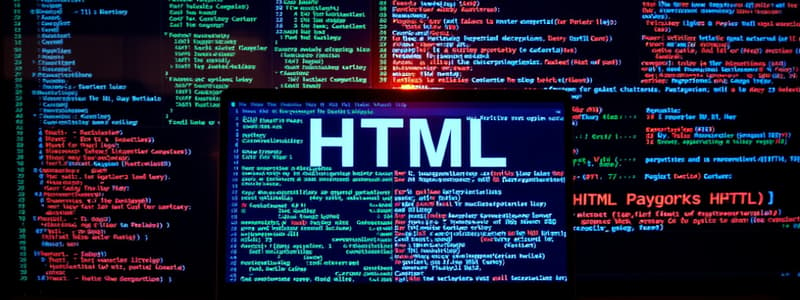Podcast
Questions and Answers
What does HTML stand for?
What does HTML stand for?
- Hypertext Markup Language (correct)
- Hypertext Multilayer Language
- Hightext Multimedia Language
- Hyperlink Text Markup Language
Which tag is used to declare the document as HTML5?
Which tag is used to declare the document as HTML5?
- <html>
- <head>
- <body>
- <doctype> (correct)
Which of the following is a self-closing tag?
Which of the following is a self-closing tag?
- <p>
- <h1>
- <div>
- <img> (correct)
What is the purpose of HTML attributes?
What is the purpose of HTML attributes?
Which of the following specifies an unordered list in HTML?
Which of the following specifies an unordered list in HTML?
Which HTML tag is primarily used to define the main heading of a document?
Which HTML tag is primarily used to define the main heading of a document?
What does semantic HTML refer to?
What does semantic HTML refer to?
Which of the following is NOT considered a best practice for writing HTML?
Which of the following is NOT considered a best practice for writing HTML?
Which HTML5 feature is used for drawing graphics?
Which HTML5 feature is used for drawing graphics?
What is the purpose of HTML forms?
What is the purpose of HTML forms?
Flashcards are hidden until you start studying
Study Notes
ICT: HTML Study Notes
-
Definition of HTML
- Stands for Hypertext Markup Language.
- Standard markup language for creating web pages.
-
Basic Structure of an HTML Document
<!DOCTYPE html>: Declares the document as HTML5.<html>: Root element of the HTML page.<head>: Contains meta-information (title, links to stylesheets, etc.).<title>: Sets the title of the web page (displayed in the browser tab).<body>: Contains the content of the web page (text, images, links, etc.).
-
HTML Elements
- Elements are defined by tags, usually in pairs (opening and closing).
- Example:
<p>for paragraphs,<h1>to<h6>for headings.
- Example:
- Self-closing tags:
<br>,<img>,<hr>.
- Elements are defined by tags, usually in pairs (opening and closing).
-
Common HTML Tags
- Headings:
<h1>to<h6> - Paragraphs:
<p> - Links:
<a href="URL">Link Text</a> - Images:
<img src="URL" alt="description"> - Lists:
- Unordered:
<ul><li>Item</li></ul> - Ordered:
<ol><li>Item</li></ol>
- Unordered:
- Headings:
-
Attributes
- Provide additional information about elements.
- Common attributes:
id,class,style,src,href,alt. - Format:
<element attribute="value">.
- Common attributes:
- Provide additional information about elements.
-
Nested Elements
- Elements can be contained within other elements.
- Example:
<div><p>Text in a paragraph</p></div>.
- Example:
- Elements can be contained within other elements.
-
HTML Forms
- Used to collect user input.
- Basic structure:
<form action="URL" method="POST or GET">- Input types:
<input type="text">,<input type="radio">,<input type="checkbox">,<textarea>,<select>.
-
Semantic HTML
- Using HTML tags that convey meaning about the content.
- Examples:
<header>,<nav>,<article>,<footer>,<section>.
-
HTML5 Features
- New input types (date, color, range).
- Multimedia support:
<audio>and<video>tags. - Canvas element for graphics:
<canvas>.
-
Best Practices
- Use semantic HTML for better accessibility and SEO.
- Keep HTML clean and well-structured.
- Validate HTML code to ensure compliance with standards.
Definition of HTML
- Hypertext Markup Language (HTML) is the standard language for creating web pages.
- HTML is the backbone of web content, structuring text, images, and links.
Basic Structure of an HTML Document
<!DOCTYPE html>indicates that the document is HTML5.<html>is the root element encapsulating all other HTML elements.<head>contains meta-information such as title and links to stylesheets.<title>specifies the web page title, displayed in the browser tab.<body>holds the visible content of the web page.
HTML Elements
- HTML elements are denoted by tags, commonly existing in pairs (opening and closing).
- Examples include:
- Paragraphs:
<p> - Headings:
<h1>to<h6>
- Paragraphs:
- Self-closing tags don’t require a closing part, such as
<br>,<img>, and<hr>.
Common HTML Tags
- Headings:
<h1>to<h6>categorize content hierarchy. - Paragraphs:
<p>encases text blocks. - Links: Defined using
<a href="URL">Link Text</a>. - Images: Insert images with
<img src="image.jpg" alt="description">. - Lists:
- Unordered lists use
<ul><li>Item</li></ul>. - Ordered lists use
<ol><li>Item</li></ol>.
- Unordered lists use
Attributes
- Attributes add specific information to elements.
- Common attributes include:
id(unique identifier)class(categorizes elements)style(applies CSS styles)src(source for images)href(destination for links)alt(alternative text for images).
- Attribute format:
<tagname attribute="value">.
Nested Elements
- HTML elements can be nested within one another, enhancing the document structure.
- Example:
<p><strong>Text in a paragraph</strong></p>includes strong emphasis within a paragraph.
HTML Forms
- Forms facilitate user input collection for various purposes.
- Basic form structure includes:
<form>tag to define the form.- Input types such as
<input type="text">,<input type="email">,<input type="password">,<input type="checkbox">, and<input type="submit">.
Semantic HTML
- Semantic HTML utilizes tags that impart meaning about the content, enhancing readability and accessibility.
- Important semantic elements include
<header>,<footer>,<article>,<section>, and<nav>.
HTML5 Features
- Introduces new input types (date, color, range) for enhanced usability.
- Supports multimedia with
<audio>and<video>tags for media integration. - The
<canvas>element allows for dynamic graphics creation via scripting.
Best Practices
- Implement semantic HTML to improve accessibility and search engine optimization (SEO).
- Maintain clean, organized, and well-structured HTML code for better readability.
- Validate HTML against standards to ensure compliance and error-free execution.
Studying That Suits You
Use AI to generate personalized quizzes and flashcards to suit your learning preferences.




